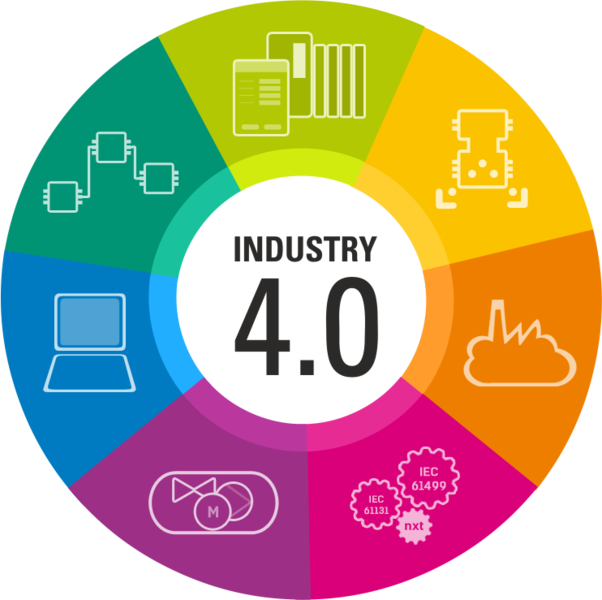
Industry 4.0
Tranform your business with technology available from HMK TODAY!
Industry 4.0 is all about optimisation— smart, flexible supply chains, factories and distribution models where machines capture and convey more data via machine-to machine communications and to human operators. All this aims to enable businesses to make quicker, smarter decisions, all while minimising costs.
Read on to learn more about how you can realise this concept through technology readilly available today.

Robotics
Robots are tough, fast and extreamly accurate, resulting in the completion of their tasks faster, with better quality and for a lower price than humans. Why then should we keep the human factor, which can produce errors, and deal with collaborative robots?
Some operations have to be adapted to actual conditions. Robots are limited by their programming. Manipulation robots are usually designed to have six or seven degrees of freedom (motion axes) while the upper limb of human body has around thirty. This results in some limitations for robots – precise manipulation with a large range of motion.
Therefore, there are two barriers between operations performed by a human laborer and a robot.
Human – Robot Collaboration breaks through these barriers and prospers from advantages of machines in challenging applications with required presence of operating personnel.
They are designed to be safe around people, either by force limiting to avoid injury if they touch, by sensors that prevent touching or by a combination of both.
So what are collaborative robots?
- They are often relatively light weight and can be moved from task to task as needed.
- They do not require skill to program. Most cobots are simple enough that anyone who can use a smartphone or tablet can teach or program them.
- Just as a power saw is intended to help, not replace, the carpenter, the cobot is generally intended to assist, not replace, the production worker.
- Collaborative robots are generally simpler than more traditional robots, which makes them cheaper to buy, operate and maintain.


Digitilisation
Imagine a world where you could streamline and digitalise your entire business process, seamlessly integrating suppliers into the mix.
Well...The digital enterprise is already a reality
It is possible to use crucial information needed for decision-making to individually tailor services to customers of component manufacturers and improve products accordingly.
Mechanical engineers can select service data from the machines and thus track causes of malfunctions on service assignments more accurately.
Plant manufacturers can compare power consumption values and detect machine malfunctions early on so as to avoid machine downtime.
OEMs can give recommendations on how to optimize production, extend the warranty if machines are well maintained, and offer new business models for plants and machines, such as "pay per use".
All this is made possible through the use of Siemens PLM Software Suite.
Industrial Internet Of Things
The advent of the IIoT brings together the things of the industrial sector, countless pieces of industrial equipment, machines, production facilities, plants, with smart devices, and the cloud, which hosts the software and analytics for making decisions based on data from the things.
The IIoT vision of the world is one where smart connected assets (the things) operate as part of a larger system or systems of systems that make up the smart manufacturing enterprise. The “things” possess varying levels of intelligent functionality, ranging from simple sensing and actuating, to control, optimisation and full autonomous operation.
Every machine and system in your business holds a wealth of data and a recent worldwide market study by Berg Insight predicts that by 2020 there will be 43.5 million IoT devices in industrial automation.
But what good does it do if your machine or factory is internet-connected? How can it benefit you and your business?
For industrial equipment, the idea is not to just add sensors everywhere. The strategy is to collect information that drives business objectives, resolves a technical or operational bottleneck, and meets industry standards and regulations.
Many low cost and previously dumb devices are now capable of capturing and publishing information about their operation in real time. By harnessing and distributing the wealth of data created by previously unconnected, non-automated processes and equipment, companies can collect and analyse operational data from all areas of their business, which drives efficiencies and reduces costs.
The major goals include optimization, reliability and new value creation (reducing downtime, extending asset life, reducing failure).
Interested in a live demonstration with real technology? Contact us now to book a slot or call 01260 279 411









